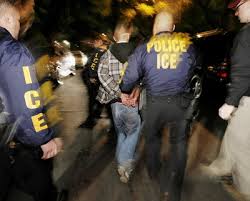One of the most disturbing items coming out of the recent spate of immigration crackdowns is the break-up of families. This new focus puts economic skills above keeping families together. The impact of these crackdowns has been palpable in the Hispanic community as the most vulnerable are targeted. As videos spread of ICE raids, fear has increased among the American-born and foreign-born Hispanic population alike.
I sense that many white Catholics have acquiesced to this policy, wrapping themselves in the “law and order” defense. But our leaders have not. Cardinal Tobin led a rally protesting a deportation, Cardinal Cupich issued directives banning ICE from churches and schools, Bishop McElroy criticized the federal government’s policies and called for widespread opposition to deportations, and the American bishops along the border issued a statement on immigration. Archbishop Gomez, who has traditionally been considered culturally conservative, is speaking out against the strict new policies. These leaders understand the value of reassuring Hispanics of their support.
Bishop McElroy’s statement pointed out that there are 200 thousand undocumented Catholics in his Diocese. His pastoral impulse is to shepherd his flock. But he has received flak from politically conservative Catholics in his Diocese. Just as the Irish and Polish immigrants changed the American Catholic church, Hispanic immigration holds the key to the future of American Catholicism and Catholic schools, too.
As church attendance and Catholic school enrollments have fallen, the number of young Catholics have swollen due to the Hispanic population. For example, there are 12.4 million school-age Hispanics in the US. If 10% of that population were to enroll in Catholic schools, the total current enrollment would double.
If you want to read a scholarly report discussing these issues, Boston College’s “Catholic Schools in an Increasingly Hispanic Church” is the gold standard. Published last year, the report describes the context and offers solutions to attracting and retaining Hispanic students in order to build a stronger church.
In the spirit of solidarity, Catholic schools should be offering resources to immigrants like the Justice for Immigrants project of the USCCB. There is now an app for undocumented immigrants to assist in dealing with deportation issues. In Los Angeles, the Catholic schools offered a FAQ to principals about the immigration issues similar to the one offered in the Archdiocese of Chicago. The LA Archdiocese is co-sponsoring information nights. Why can’t we do more? In Sacramento, for example, the public school system launched a program to assist undocumented families. Catholic schools could and should be offering more explicit support to undocumented immigrants in order to show solidarity and continue to welcome their Hispanic brethren.
Want to learn more? On Monday’s podcast, I’ll interview Dr. Luis Fraga from Notre Dame and on Thursday’s podcast, I’ll interview Dr. Hosffman Ospino from Boston College. These two Hispanic Catholic scholars share insights on the growing influence of the Hispanic population and their role in the Church. Here is a preview link to Dr. Fraga’s podcast and to Dr. Ospino’s podcast.

I am so torn on this issue of immigrants with respect to “what’s” right and “who’s right. You see I keep coming back to the bible scripture in Luke 20:25: “Give to God what is God’s and to Caesar what is Caesar’s.” On the one hand, we are to be obedient, respectful and supportive of our earthly leaders. On the other, I can see and feel the moral wrong of breaking-up families merely because immigrants are in our country illegally.
What if it’s the government’s position not to target ALL undocumented immigrants or to break-up families per se, rather only CRIMINAL illegals? Is that approved by the Church? Would the arrest and deportation of “criminal” gang members, drug dealers and chronic criminal offenders remove the “sanctuary” auspice under which the Church acts?
On a tangential yet still related note, I grew up with a tough, Mexican dad who was not formally educated yet read and knew a lot and talked to us 13 brothers and sisters a lot—especially when he was boozing it up. I loved him and I loved when he would stretch our thinking—even though I sometimes didn’t know if he was just telling us stuff to inspire us to work on his farm or to really share his wisdom.
For example, I’ll never forget when he told me about a long ago Catholic Principle of Subsidiary. The Constitution does not include education as one of government’s functions. However, on a more philosophical level, the framers of America’s limited government had a broad allegiance to what Catholics call the Principle of Subsidiarity. In the secular world, the principle of subsidiary means that local government should do only those things that individuals cannot do for themselves; state government should do only those things that local government cannot do; and the federal government should do only those things that the individual states cannot do. Education is something that individuals acting alone and cooperatively can do, let alone something local and state governments can do.
My father’s words and wisdom ring in my mind today, for I wonder if—we and the Church–are doing for undocumented immigrants what the government is not doing.
Lastly, it’s important to know and understand when we go through trying times and the “known” facts are seemingly against us, all the known facts are not ALL the facts. and certainly not ALL God knows.